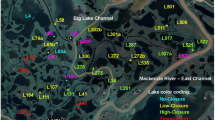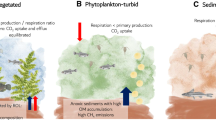Abstract
Freshwaters are important sources of the greenhouse gases methane (CH4) and carbon dioxide (CO2) to the atmosphere. Knowledge about temporal variability in these fluxes is very limited, yet critical for proper study design and evaluating flux data. Further, to understand the reasons for the variability and allow predictive modeling, the temporal variability has to be related to relevant environmental variables. Here we analyzed the effect of weather variables on CH4 and CO2 flux from a small shallow pond during a period of 4 months. Mean CH4 flux and surface water CH4 concentration were 8.0 [3.3–15.1] ± 3.1 mmol m−2 day−1 (mean [range] ± 1 SD) and 1.3 [0.3–3.5] ± 0.9 µM respectively. Mean CO2 flux was 1.1 [−9.8 to 16.0] ± 6.9 mmol m−2 day−1. Substantial diel changes in CO2 flux and surface water CH4 concentration were observed during detailed measurements over a 24 h cycle. Thus diel patterns need to be accounted for in future measurements. Significant positive correlations of CH4 emissions with temperature were found and could include both direct temperature effects as well as indirect effects (e.g. related to the growth season and macrophyte primary productivity providing organic substrates). CO2 flux on the other hand was negatively correlated to temperature and solar radiation, presumably because CO2 consumption by plants was higher relative to CO2 production by respiration during warm sunny days. Interestingly, CH4 fluxes were comparable to ponds with similar morphometry and macrophyte abundance in the tropics. We therefore hypothesize that CH4 and CO2 summer emissions from ponds could be more related to the morphometry and dominating primary producers rather than latitude per se. Data indicate that CH4 emissions, given the system characteristic frameworks, is positively affected by increased temperatures or prolonged growth seasons.




Similar content being viewed by others
References
Bastviken D, Cole J, Pace M, Tranvik L (2004) Methane emissions from lakes: dependence of lake characteristics, two regional assessments, and a global estimate. Glob Biogeochem Cycle 18(4):GB4009
Bastviken D, Santoro AL, Marotta H, Pinho LQ, Calheiros DF, Crill P, Enrich-Prast A (2010) Methane emissions from pantanal, South America, during the low water season: toward more comprehensive sampling. Environ Sci Technol 44(14):5450–5455
Bastviken D, Tranvik LJ, Downing JA, Crill PM, Enrich-Prast A (2011) Freshwater methane emissions offset the continental carbon sink. Science 331(6013):50
Battin TJ, Luyssaert S, Kaplan LA, Aufdenkampe AK, Richter A, Tranvik LJ (2009) The boundless carbon cycle. Nat Geosci 2(9):598–600
Casper P, Maberly SC, Hall GH, Finlay BJ (2000) Fluxes of methane and carbon dioxide from a small productive lake to the atmosphere. Biogeochemistry 49(1):1–19
Cole JJ, Bade DL, Bastviken D, Pace ML, Van de Bogert M (2010) Multiple approaches to estimating air-water gas exchange in small lakes. Limnol Oceanogr Methods 8:285–293
Crill PM, Bartlett KB, Wilson JO, Sebacher DI, Harriss RC, Melack JM, MacIntyre S, Lesack L (1988) Tropospheric methane from an Amazonian floodplain lake. J Geophys Res 93:1564–1570
Denman KL, Brasseur G, Chidthaisong A, Ciais P, Cox PM, Dickinson RE, Hauglustaine D, Heinze C, Holland E, Jacob D, Lohmann U, Ramachandran S, da Silva Dias PL, Wofsy SC, Zhang X (2007) Couplings between changes in the climate system and biogeochemistry. In: Solomon S, Qin D, Manning M et al. (eds) Climate change 2007: the physical science basis. Contribution of working group I to the fourth assessment report of the intergovernmental panel on climate change. Cambridge University Press, Cambridge, pp 499–588
Downing JA (2009) Global limnology: up-scaling aquatic services and processes to planet Earth. Verh Internat Verein Limnol 30(8):1149–1166
Downing JA, Prairie YT, Cole JJ, Duarte CM, Tranvik LJ, Striegl RG, McDowell WH, Kortelainen P, Caraco NF, Melack JM, Middelburg JJ (2006) The global abundance and size distribution of lakes, ponds, and impoundments. Limnol Oceanogr 51(5):2388–2397
Duc N, Crill P, Bastviken D (2010) Implications of temperature and sediment characteristics on methane formation and oxidation in lake sediments. Biogeochemistry 100(1):185–196
Dumestre JF, Guézennec J, Galy-Lacaux C, Delmas R, Richard S, Labroue L (1999) Influence of light intensity on methanotrophic bacterial activity in Petit Saut reservoir, French Guiana. Appl Environ Microbiol 65(2):534–539
Flanagan KM, McCauley E (2008) Warming and depth interact to affect carbon dioxide concentration in aquatic mesocosms. Freshw Biol 53(4):669–680
Granato GE (2006) Kendall-Theil Robust Line (KTRLine-version 1.0)—a visual basic program for calculating and graphing robust nonparametric estimates of linear-regression coefficients between two continuous variables. Techniques and methods of the U.S. Geological Survey, Book 4, Chap. A7. U.S. Geological Survey, Virginia
Gudasz C, Bastviken D, Steger K, Premke K, Sobek S, Tranvik LJ (2010) Temperature-controlled organic carbon mineralization in lake sediments. Nature 466(7305):478–481
Hamilton JD, Kelly CA, Rudd JWM, Hesslein RH, Roulet NT (1994) Flux to the atmosphere of CH4 and CO2 from wetland ponds on the Hudson Bay lowlands (HBLs). J Geophys Res Atmos 99(D1):1495–1510
Helsel DR, Hirsch RM (2002) Statistical methods in water resources. Techniques of water resources investigations, Book 4, Chap. A3. U.S. Geological Survey, Virginia
Huotari J, Ojala A, Peltomaa E, Pumpanen J, Hari P, Vesala T (2009) Temporal variations in surface water CO2 concentration in a boreal humic lake based on high-frequency measurements. Boreal Environ Res 14:48–60
Huttunen JT, Alm J, Liikanen A, Juutinen S, Larmola T, Hammar T, Silvola J, Martikainen PJ (2003) Fluxes of methane, carbon dioxide and nitrous oxide in boreal lakes and potential anthropogenic effects on the aquatic greenhouse gas emissions. Chemosphere 52(3):609–621
Juutinen S, Rantakari M, Kortelainen P, Huttunen JT, Larmola T, Alm J, Silvola J, Martikainen PJ (2009) Methane dynamics in different boreal lake types. Biogeosciences 6(2):209–223
Kortelainen P, Rantakari M, Huttunen JT, Mattsson T, Alm J, Juutinen S, Larmola T, Silvola J, Martikainen PJ (2006) Sediment respiration and lake trophic state are important predictors of large CO2 evasion from small boreal lakes. Glob Change Biol 12(8):1554–1567
Kosten S, Roland F, Da MM, Van Nes EH, Mazzeo N, Sternberg LdSL, Scheffer M, Cole JJ (2010) Climate-dependent CO2 emissions from lakes. Glob Biogeochem Cycle 24(2):GB2007
Liikanen A, Murtoniemi T, Tanskanen H, Väisänen T, Martikainen PJ (2002) Effects of temperature and oxygen availability on greenhouse gas and nutrient dynamics in sediment of a eutrophic mid-boreal lake. Biogeochemistry 59(3):269–286
Marotta H, Duarte CM, Sobek S, Enrich-Prast A (2009) Large CO2 disequilibria in tropical lakes. Glob Biogeochem Cycle 23(4):GB4022
Mattson MD, Likens GE (1990) Air pressure and methane fluxes. Nature 347(6295):718–719
Michmerhuizen CM, Striegl RG, McDonald ME (1996) Potential methane emission from north-temperate lakes following ice melt. Limnol Oceanogr 41(5):985–991
Murase J, Sugimoto A (2005) Inhibitory effect of light on methane oxidation in the pelagic water column of a mesotrophic lake (Lake Biwa, Japan). Limnol Oceanogr 50(4):1339–1343
Rantakari M, Kortelainen P (2005) Interannual variation and climatic regulation of the CO2 emission from large boreal lakes. Glob Change Biol 11(8):1368–1380
Segers R (1998) Methane production and methane consumption: a review of processes underlying wetland methane fluxes. Biogeochemistry 41(1):23–51
Sellers P, Hesslein RH, Kelly CA (1995) Continuous measurement of CO2 for estimation of air-water fluxes in lakes: an in situ technique. Limnol Oceanogr 40(3):575–581
Tranvik LJ, Downing JA, Cotner JB, Loiselle SA, Striegle RG, Ballatore TJ, Dillon P, Finlay K, Fortino K, Knoll LB, Kortelainen PL, Kutser T, Larsen S, Laurion I, Leech DM, McCallister SL, McKnight DM, Melack JM, Overholt E, Porter JA, Prairie Y, Renwick WH, Roland F, Sherman BS, Schindler DW, Sobek S, Tremblay A, Vanni MJ, Verschoor AM, von Wachenfeldt E, Weyhenmeyera GA (2009) Lakes and reservoirs as regulators of carbon cycling and climate. Limnol Oceanogr 54(6):2298–2314
Utsumi M, Nojiri Y, Nakamura T, Nozawa T, Otsuki A, Seki H (1998) Oxidation of dissolved methane in a eutrophic, shallow lake: lake Kasumigaura, Japan. Limnol Oceanogr 43(3):471–480
Van der Nat F, Middelburg JJ, Van Meteren D, Wielemakers A (1998) Diel methane emission patterns from Scirpus lacustris and Phragmites australis. Biogeochemistry 41(1):1–22
van Hulzen JB, Segers R, van Bodegom PM, Leffelaar PA (1999) Temperature effects on soil methane production: an explanation for observed variability. Soil Biol Biochem 31(14):1919–1929
Walter KM, Zimov SA, Chanton JP, Verbyla D, Chapin FS (2006) Methane bubbling from Siberian thaw lakes as a positive feedback to climate warming. Nature 443(7107):71–75
Wiesenburg DA, Guinasso NL (1979) Equilibrium solubilities of methane, carbon monoxide, and hydrogen in water and sea water. J Chem Eng Data 24(4):356–360
Xing YP, Xie P, Yang H, Ni LY, Wang YS, Rong KW (2005) Methane and carbon dioxide fluxes from a shallow hypereutrophic subtropical Lake in China. Atmos Environ 39(30):5532–5540
Zhu RB, Liu YS, Xu H, Huang T, Sun JJ, Ma ED, Sun LG (2010) Carbon dioxide and methane fluxes in the littoral zones of two lakes, east Antarctica. Atmos Environ 44(3):304–311
Acknowledgments
We thank Henrik Reyier for his help in sampling and analysis of this study. Magnus Öhrman and Ulf Jacobsson from Akademiska Hus kindly provided the weather data and the information about the studied pond.
Author information
Authors and Affiliations
Corresponding author
Additional information
Responsible Editor: E. Veldkamp.
Rights and permissions
About this article
Cite this article
Natchimuthu, S., Panneer Selvam, B. & Bastviken, D. Influence of weather variables on methane and carbon dioxide flux from a shallow pond. Biogeochemistry 119, 403–413 (2014). https://doi.org/10.1007/s10533-014-9976-z
Received:
Accepted:
Published:
Issue Date:
DOI: https://doi.org/10.1007/s10533-014-9976-z




